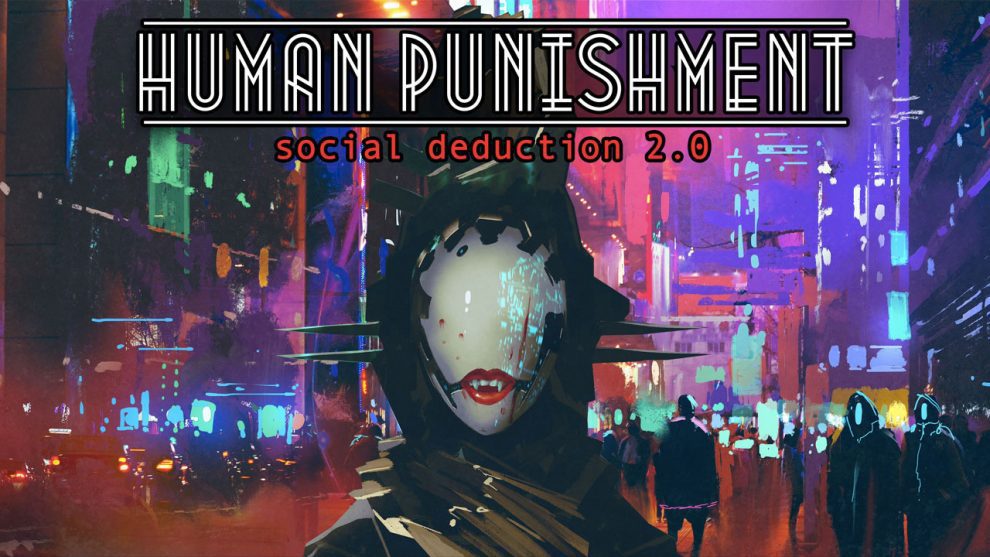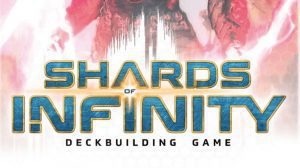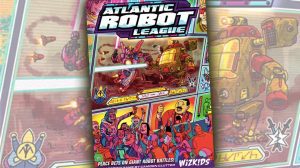Here we go again. Another game that loves to declare itself as the next big thing for social deduction games. I’ve seen this happen with games like Witch Hunt and Human Punishment tries to self-declare as a “2.0” of the genre. I find that proclaimed title to be funny since this is a complicated variation of Bang and Good Cop, Bad Cop. I don’t like either game, but they were some decent mechanics and with some finesse, this hybrid can work well. Let’s see if Human Punishment has the right to label itself as a 2.0 of social deduction.
There are three factions: Outlaws, Humans, and Machines. Humans want to kill everyone but not themselves and Machines want to eliminate all humans. Outlaws want to be the last one standing and I don’t mean as a team. An Outlaw wants to be the sole player surviving this chaos.
You will be getting two Loyalty cards and an ID card. The Loyalty cards will show one of the three factions, while your ID card shows you a special power and the faction associated with that power. Whatever faction you have the majority in, that’s your team. Any ties mean you are an Outlaw. After having a good look at your three cards, you’ll put them face down in front of you.
I love this faction set up for several reasons. With this random setup, it means no one knows how many players are in their faction and the ID cards mean different matchups every single game. To make the situation more volatile, some ID cards force you to put in a particular faction, meaning the two Loyalty cards are red herrings for everyone else. Without any exaggeration, there are loads of variety in this tiny box.
/pic4042165.jpg)
Snappy Pace
Going through a turn is straightforward. If you don’t have a weapon, you have one action to spend and there are three different actions. You can investigate another player by looking at one of their loyalty cards or if the loyalty cards are already face-up, look at their ID. You can also pick up one of the available weapons in the middle of the table and aim it to another player. The third option is to draw a program card.
But if you have a weapon at the start of your turn, your available actions change. You can drop your weapon and place it back in the middle of the table. If you like, you can also point to a different target. The final option is to shoot your weapon and each weapon has a special effect. For the most part, it’s usually involving your target revealing one of their face-down cards or taking damage. Take two points of damage and you are eliminated.
Based on what I’ve described so far, the general impression will likely lead you to believe that this game is quick-paced with easy rules and ends within a reasonable timeframe, right?
I wish that was the case.
/pic4084306.jpg)
How Not To Handle Player Elimination
Let’s get started with the biggest issue in the room: Player elimination. Throughout the years, the mere suggestion of player elimination in a board game will make players run for the hills or use blue tarp to cover the game. The reason behind this is pulling off player elimination isn’t an easy task for a game designer. You can either make the game so short where it’s irrelevant such as Coup, or you can have elimination near the end where the game’s conclusion is mere minutes away.
Before I start ranting about the flaws, I will sing some of my praises. Even though this game is a blatant rip off of Bang and Good Cop, Bad Cop, I did enjoy the idea of multiple factions going at it and the slow information gathering by investigating loyalty and ID cards. Veterans and newbies of the genre can easily comprehend their surroundings as they have to consider various options such as the reveal of any information they find or announce what team they are on. Going through a turn isn’t difficult either so players who aren’t accustomed to social deduction games might still find something to grasp here.
Even the existence of ID cards warrants some form of applause. At the start of the game, ID cards are not revealed, therefore no powers are used. As the game escalates by everyone shooting each other, these cards are revealed and the board state changes with various powers going off. Combine this avalanche effect with the random powers everyone gets each game and you have something that is an interesting dilemma for everyone. It’s like this game is this efficient racing car able to slice through a track with ease.
Too bad the driver is incompetent.
Why Won’t It End
Program cards are your typical “take that” cards where you play the card, follow the instructions, and discarding it. Some of these cards are permanent upgrades, meaning they stay on the field but count towards your hand limit.
I understand why game designers use this type of mechanism in their game. Instead of creating an elaborate system where various states of the game can occur, you can simply smack some text on a card and declare there has been a change. It’s a bit lazy but can work and it isn’t a hurdle for new players.
But like any mechanism in game design, “take that” cards are a tool and misusing them will lead to disastrous results. Most of the program cards in this game often prolong and disrupt the game in a negative way. For a game that has player elimination, having cards that make the game take longer simply doesn’t work.
I’ll give you a few example cards to demonstrate this absurdity. “Banned IP” is a card played out of turn that turns damage from an attack into a healing effect. In other words, the two turns the target has spent to fire at someone heals them instead of damaging them, therefore potentially reversing the progress of the game. “Ping 666” is a card that skips another player’s turn and “New Timezone” reverses turn order. Why are there UNO cards in a social deduction game?
404 Deduction Not Found
It’s even hard to call this social deduction because deduction would imply logical patterns to decipher. Due to the program cards, this isn’t possible. 10% of the program deck consists of loyalty cards that could potentially change the team you are on. To make matters worse, they cannot be discarded and go against your hand limit. Not only does this change the team you are on, which can erase any progress you have made, but it also robs you from using the game’s other tools to play around with. Again, why?
It is unfortunate because some program cards are fun to play. You can force someone to pick a new target with their weapon, show someone all of your face down cards, or equip a powerful weapon that no one else has access to. These are enjoyable tools to abuse and it gives the variety the game needs since the foundations are very simple. Some of these are still disruptive, but not nearly to the point of delaying the game or a major source of frustration.
The underlying issue with Human Punishment is it’s a 30-minute game that pretends it isn’t a 30-minute game. From reading the rules and examining the flow of the game, it should be quick but the designer managed to throw in as much gunk as they can to prolong the game which doesn’t make sense. Why would you want a game where most of the decision is based on card draws to last close to 2 hours and throw in player elimination on top of that? This is a perfect example of “less is more” and there are far better options for social deduction games such as Resistance: Avalon, Blood on the Clocktower, and Dark Moon.











Hi there, designer here 😉
Thank you for your blog, even if you don‘t like the game.
Huma Punishment should never be short game like coup (and Iove Coup btw!!). The plan was to bring more „epic“ moments to the table and a little bit more playtime and lots of more mechanics and new ideas to involve players… and our community rly enjoys this (we sold over 20.000 copies and new publishers with new languages still join us). Human Punishment has still the highest user average social deduction score on BGG…. but it is absolutely fine, not every player enjoys it
wish u the best
Stefan
It’s worth noting that the scoring metric for BGG is just the opinion of folk who go on BGG which as far as I understand aren’t the most discerning audience.
Equally so, 20,000 might mean a lot commercially but from a design perspective, there are a lot of bad games that have outperformed much better games commercially. People will largely buy what is waved in front of them so long as it looks pretty and has a distinct appeal to it.
My point being that you shouldn’t let sales and commercial success dilute your ambition as a designer. The points made in the review are very logical and fair and if you were looking to improve you’d see past the ‘negative review’ veneer and see that these are really good observations that could help you improve your next game.